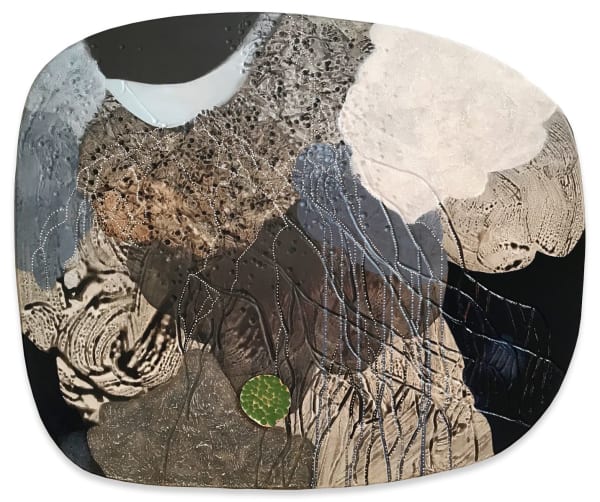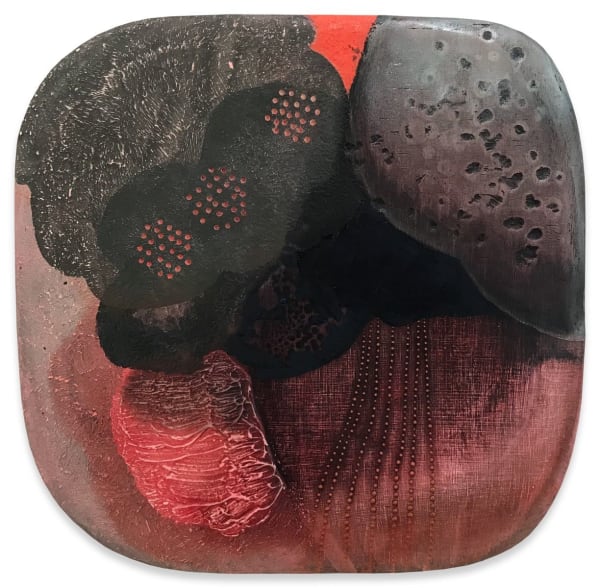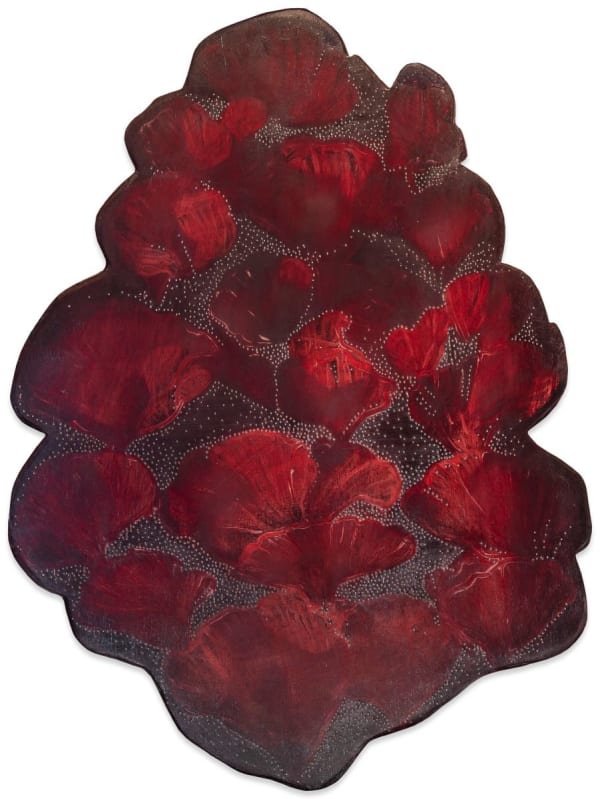Emma Walker: The Dark Sublime
-
 Emma WalkerAbove and Beneath, 2019oil & mixed media on board39 x 40 cm
Emma WalkerAbove and Beneath, 2019oil & mixed media on board39 x 40 cm -
 Emma WalkerAquifer II, 2019oil & mixed media on board105 x 124 cm
Emma WalkerAquifer II, 2019oil & mixed media on board105 x 124 cm -
 Emma WalkerConnection, 2019oil & mixed media on board27 x 29 cm
Emma WalkerConnection, 2019oil & mixed media on board27 x 29 cm -
 Emma WalkerDark Sublime, 2019oil & mixed media on board146 x 178 cm
Emma WalkerDark Sublime, 2019oil & mixed media on board146 x 178 cm -
 Emma WalkerEmergence, 2019oil & mixed media on board27 x 33 cm
Emma WalkerEmergence, 2019oil & mixed media on board27 x 33 cm -
 Emma WalkerExchange, 2019oil & mixed media on board30 x 30 cm
Emma WalkerExchange, 2019oil & mixed media on board30 x 30 cm -
 Emma WalkerForest Light, 2019oil & mixed media on board30 x 30 cm
Emma WalkerForest Light, 2019oil & mixed media on board30 x 30 cm -
 Emma WalkerHolding Hands Underground, 2019oil & mixed media on board145 x 290 cm
Emma WalkerHolding Hands Underground, 2019oil & mixed media on board145 x 290 cm -
 Emma WalkerLife Cycle, 2019oil & mixed media on board150 x 176 cm
Emma WalkerLife Cycle, 2019oil & mixed media on board150 x 176 cm -
 Emma WalkerMetamorphic, 2019oil & mixed media on board30 x 31 cm
Emma WalkerMetamorphic, 2019oil & mixed media on board30 x 31 cm -
 Emma WalkerNew Growth, 2019oil & mixed media on board30 x 30 cm
Emma WalkerNew Growth, 2019oil & mixed media on board30 x 30 cm -
 Emma WalkerNight Pool, 2019oil & mixed media on board128 x 113 cm
Emma WalkerNight Pool, 2019oil & mixed media on board128 x 113 cm -
 Emma WalkerPleurotus, 2019oil & mixed media on board79.5 x 60 cm
Emma WalkerPleurotus, 2019oil & mixed media on board79.5 x 60 cm -
 Emma WalkerQuiet Light, 2019oil & mixed media on board40 x 30 cm
Emma WalkerQuiet Light, 2019oil & mixed media on board40 x 30 cm -
 Emma WalkerRunoff, 2019oil & mixed media on board125 x 152 cm
Emma WalkerRunoff, 2019oil & mixed media on board125 x 152 cm -
 Emma WalkerSilent Night, 2019oil & mixed media on board30 x 30 cm
Emma WalkerSilent Night, 2019oil & mixed media on board30 x 30 cm -
 Emma WalkerSky Reach, 2019oil & mixed media on board36 x 39 cm
Emma WalkerSky Reach, 2019oil & mixed media on board36 x 39 cm -
 Emma WalkerUnderstory, 2019oil & mixed media on board118 x 140 cm
Emma WalkerUnderstory, 2019oil & mixed media on board118 x 140 cm
The world we see is a world we know. That which is above the surface. However, a small investigation into an unseen world enables us to glimpse at its enormous complexity, intricacies and layers. In ‘The Dark Sublime’, Emma Walker takes a poetic imagining to nature’s world of interconnectivity that exists underground and on the forest floor.
Walking in old-growth forests, one cannot help but notice the order with which they are arranged. These are places of staggering biodiversity. Trees and undergrowth appear to find their ideal positions, water is regulated, and nutrients cycled, climate and humidity is moderated. Looking up into the forest canopy, branches grow towards each other in balance and apparent harmony, as though they know how far to reach without disrupting their neighbours, or the light requirements of what is beneath them. Plants seem to sense each other’s bodies, and grow for the health of the forest. Their lives are more than individual marathons to out-compete one another, and grow big and wide towards the sun.
The intelligence of the forest is visible in terms of how it adapts and responds to its environment, but what of that which is below the surface? Fingers in soil find a delicate web of white thread-like forms known as mycelia, or mycorrhizal fungi. These connect and interact with the root systems of trees, forming a symbiotic partnership. With the help of mycelium appropriate to a given tree, that tree can better meet its requirements for nitrogen, phosphorus, nutrients and water. These white fungal webs also grow out towards other trees of the same and different species, creating a network of communication and exchange, allowing the forest to behave as though it were a single organism. Sugar from the trees feeds the fungi, and in return they scavenge the soil for nitrogen, phosphorus and other mineral nutrients to share among the plants. The fungi and tree-roots work to shuffle resources around this network, according to who needs what.1
Understanding of ecosystems is well-established, but knowledge of mycorrhizal fungi, which can extend for kilometres under a single footstep, is relatively new science. Ideas about this hidden language of trees have captured Walker’s imagination, informed by literature such as The Hidden Life of Trees by Peter Wohlleben and The Overstory by Richard Powers. Walker has a deep respect for nature, but also honesty about our fractured relationship with it. She spent part of her childhood on a bushy rural property near Cootamundra, south-west NSW, as well as living in Sydney and sailing and travelling the world with her free-spirited family. This instilled in her an awareness of the natural world that has remained with her in her adult life. For the last 18 years she has lived in the Northern Rivers, where constant balance and imbalance is visible, in patches of remnant rainforest, and in disrupted land covered with weeds such as farmer’s friend, lantana and camphor laurel. In this subtropical area, it is easy to imagine that if we left the land to its own devices it would find a new balance. Our impatience is that nature follows its own timeline, and the lives of mature trees in a complex ecosystem are so much longer than ours.
Walker’s new body of work makes reference to this underground intelligence. It evokes worlds of relationship, exchange and even love existing in the soil. The paintings contain electric webs inspired by mycelium, tree roots and the subterranean movements of water. These networks branch out, their tentacles searching for and connecting forms.
Works start in much the same way as a forest might, with a laying down of marks that informs and gives life and purpose to those that follow. So the paintings grow, with pioneers creating an environment for a succession of other species, and complementary forms and marks to live side by side. The process sounds harmonious, but in reality, for both nature and painter, the work involved in finding balance is arduous and continual. One tree grows up in its ideal position, but others sprout in less hospitable places, where life is not viable. In the studio, Walker follows an informed process of trial and error, struggle and epiphany.
Her works are not planned out or prescribed. Paint is applied in strokes, drips and pours, layer upon layer, and then it is wiped/scraped back in areas, sanded, and the timber substrate carved into, until the work reaches a point where she can see that it is working and a cohesion forming. In the completed works we sense this time spent making, and the density of what is below. Areas of the works are incised, and deeply textured, others drop out into dark and mysterious voids, each space appears to move and respond to the other. A clear area sets off an active one, and these hubs of information, like mother trees in the forest, give logic to the composition.
The web-like lines are also visual devices, leading the eye from one place to another, and shifting from positive to negative, and fluid brush stroke to slow, hand-carved incision. The asymmetrical forms of the paintings suggest the possibility that what is painted on the surface may extend beyond the edges and the confines of the picture plane.
Inside the paintings forms respond to each other, throwing out light, milky halos and areas of colour. They infer chemical reactions, or unseen emotions. This connected world is parallel to our own relationships, whether with kin, friends or the broader community. The networked marks could stand for many things, from mycelium, to trees’ branches, river systems, veins in the body or synapses inside the brain. The mycelium’s above-ground fruit, the mushrooms, are the only non-abstract motifs in the paintings. These are often painted or carved on board and added to the work. They allude to a different dimension, as imagery drifts from below ground to above and in between, in the fluid space of painting.
The idea that trees communicate has captivated Walker. The works in ‘The Dark Sublime’ harbour an optimism, that despite our exploitation of nature, its complexity is beyond our comprehension. One can only hope that its ability to heal is too. Nature is embattled by our exploitation of it, but we are a blip in its lifespan. Emma Walker’s paintings do not propose answers. They do not summon guilt. They are a slow walk through the forest to allow us to tune into the importance of the natural world, and the magic of painting.
Essay extract: Kezia Geddes, Curator, Lismore Regional Gallery
1Wohlleben, Peter, The Hidden Life of Trees, Black Inc., Carlton VIC, Australia, 2016
Emma Walker has elected to donate 10% of the proceeds from this exhibition to the Wilderness Society in support of their work advocating for our environment. More information on the Wilderness Society can be found here www.wilderness.org.au























